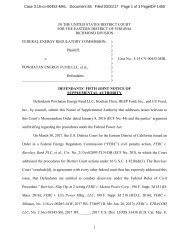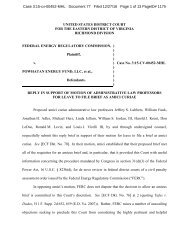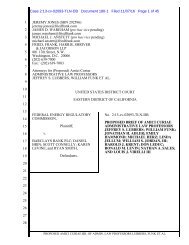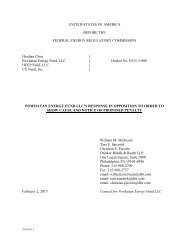FERC-Response-03-24-17
FERC-Response-03-24-17
FERC-Response-03-24-17
You also want an ePaper? Increase the reach of your titles
YUMPU automatically turns print PDFs into web optimized ePapers that Google loves.
Case 3:15-cv-00452-MHL Document 84 Filed <strong>03</strong>/<strong>24</strong>/<strong>17</strong> Page 6 of 30 PageID# 1425<br />
INTRODUCTION<br />
Petitioner has urged this Court to construe Section 31(d)(3) of the Federal Power Act<br />
(“FPA”) as authorizing this Court to conduct a “review de novo” of the Commission’s Order<br />
Assessing Penalties (the “Order”), rather than compelling this Court to conduct a plenary trial.<br />
See ECF 39 and 52. Section 31(d) of the FPA was developed during a period of significant<br />
change in the manner in which civil penalties were assessed by administrative agencies; more<br />
authority was being given by Congress to agencies to adjudicate and assess civil penalties in<br />
recognition of the expertise and efficiency that agencies bring to bear when enforcing their own<br />
rules and regulations, and as a means to reduce the burden on the judicial system. Section 31(d)<br />
exemplifies this movement, providing respondents the choice between a trial-type hearing before<br />
an Administrative Law Judge (“ALJ”), or an informal adjudication before the Commission. In<br />
both cases, the civil penalties are assessed by the Commission, in recognition of its primary<br />
jurisdiction over the complex energy regulatory regime it oversees. This context, much of which<br />
is confirmed by the very resources upon which Amici rely, gives meaning to the FPA’s structure,<br />
and significance to a respondent’s ability to choose how a penalty is assessed by the<br />
Commission.<br />
By contrast, Amici’s insistence that the statute instead provides two avenues to a plenary<br />
trial, allowing respondents to choose either the Commission or a district court to make penalty<br />
assessments, runs counter to the text, structure, and purpose of the FPA. First, Amici fail to<br />
draw the necessary and important distinction between civil penalty systems where respondents<br />
have no avenue to an evidentiary hearing before the agency, and systems like the FPA that<br />
provide a clear path to such a hearing before an ALJ. Second, Amici – while relying on their<br />
“keen interest in the proper development of federal administrative law and policy” – entirely<br />
ignore that Section 31(d) is the enforcement mechanism of a complex and comprehensive<br />
1






